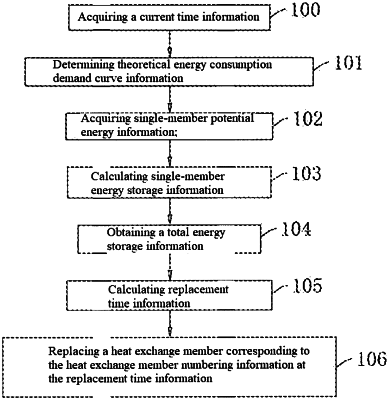| CPC F24T 10/00 (2018.05) [G06Q 10/20 (2013.01); F24T 2010/56 (2018.05)] | 7 Claims |

|
1. A shallow geothermal energy utilization and storage method based on deep learning optimization, comprising the following steps of:
acquiring current time information;
performing matching analysis on energy consumption demand curve information stored in a preset learning database and the current time information to determine an energy consumption demand curve for the current time information, and defining the energy consumption demand curve as theoretical energy consumption demand curve information;
acquiring heat exchange component number information and corresponding single-member potential energy information;
calculating single-member energy storage information according to the single-member potential energy information and preset efficiency threshold information;
calculating a sum of the single-member energy storage information corresponding to the heat exchange component number information to obtain a total stored energy information;
calculating replacement time information according to the theoretical energy consumption demand curve information and the total stored energy information; and
replacing a heat exchange component corresponding to the heat exchange component number information at a replacement time corresponding to the replacement time information;
wherein replacing the heat exchange component corresponding to the heat exchange component number information at the replacement time corresponding to the replacement time information comprises the following steps:
performing matching analysis on heat exchange rate information and the single-member energy storage information stored in a preset consumption database and the current time information to determine a heat exchange rate corresponding to the single-member energy storage information at the current time information, and defining the heat exchange rate corresponding to the single-member energy storage information as single-member heat exchange rate information;
calculating single-member consumption time information according to the single-member heat exchange rate information and the single-member energy storage information;
judging whether the single-member consumption time information is equal to the replacement time information;
when the single-member consumption time information is equal to the replacement time information, placing the heat exchange component corresponding to the heat exchange component number information into a preset energy storage area for energy storage and moving the heat exchange component in the preset energy storage area out for energy storage at the replacement time information; and
when the single-member consumption time information is smaller than the replacement time information, placing a heat exchange component corresponding to the heat exchange component number information into the preset energy storage area for energy storage at the single-member consumption time information, and moving the heat exchange component in the preset energy storage area out for energy storage at the replacement time information;
wherein placing the heat exchange component corresponding to the heat exchange component number information into the preset energy storage area for energy storage at the single-member consumption time information, and moving the heat exchange component in the preset energy storage area out for energy storage at the replacement time information comprises the following steps:
acquiring remaining energy storage information at the replacement time;
defining number information of the heat exchange component to be replaced as current replacement member number information;
performing matching analysis on cycling group number information stored in a preset group database and the current replacement member number information to determine a cycling group number in which the current replacement member number information is, and defining the cycling group number information as replacement cycling group number information;
acquiring the single-member energy storage information corresponding to other heat exchange components in the replacement cycling group number information, respectively, and defining the single-member energy storage information as the single-member energy storage information;
sequencing the remaining energy storage information and the single-member energy storage information corresponding to all the other heat exchange components in the replacement cycling group number information in a descending order to obtain a sequence number corresponding to the remaining energy storage information, defining the sequence number as energy storage sequence number information, and defining a minimum sequence number as minimum sequence number information;
acquiring position information of other heat exchange components corresponding to a sequence number adjacent to the energy storage sequence number information corresponding to the remaining energy storage information, respectively, and defining the position information as insertion area information; and
placing a heat exchange component corresponding to the current replacement member number information in the insertion area information for energy storage, and supplying energy to a heat exchange component having the minimum sequence number information as energy storage number information;
wherein calculating the preset efficiency threshold information comprises the following steps:
acquiring historical record information;
retrieving latest historical efficiency threshold information and historical replacement time information from the historical record information;
performing matching analysis on the historical replacement time information and preset suitable time range information to determine larger historical replacement time information, suitable historical replacement time information and smaller historical replacement time information;
respectively calculating proportions of the larger historical replacement time information, the suitable historical replacement time information and the smaller historical replacement time information in the historical replacement time information, defining a proportion of the larger historical replacement time information as larger proportion information, defining a proportion of the suitable historical replacement time information as suitable proportion information, and defining a proportion of the smaller historical replacement time information as smaller proportion information;
judging whether the suitable proportion information is a maximum value;
when the suitable proportion information is the maximum value, outputting the preset efficiency threshold information as the latest historical efficiency threshold information;
when the larger proportion information or the smaller proportion information is the maximum value, performing calculation on the theoretical energy consumption demand curve information corresponding to the larger historical replacement time information or the smaller historical replacement time information corresponding to the maximum value, the total stored energy information and a proper time range information to obtain updated efficiency threshold information; and
outputting the updated efficiency threshold information as the preset efficiency threshold information and updating the single-member energy storage information.
|